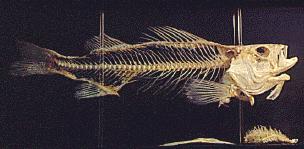







This mounted skeleton of the common perch shows several characteristics of ray-finned fish. As the name suggests, the fins are supported by parallel bony rays, which in life are webbed with thin tissue; the fins themselves contain very little muscle, and are primarily moved by muscles within the body. The skull is a complex assemblage of bones. Teleost fish -- the majority of ray-finned fishes -- have upper jaw bones (the maxilla and premaxilla) that are free from the other skull bones and move independently, sliding forward when the mouth is opened.

A platelike structure, the operculum, covers the gills; this is not present in most Chondrichthyes (except for chimaeras). The tail fin of most ray-finned fish, with the exception of sturgeons and paddlefish, is homocercal, nearly symmetrical about the midline. However, a slight upturn of the last vertebra in the tail suggests that actinopterygian tails were once heterocercal, with the vertebrae extending into the elongated upper lobe of the tail fin, like the tail fins of sharks and their allies.
The anatomy of ray-finned fish shows many of the characteristics common to all chordates: pharyngeal slits, a nerve cord, and body wall muscles arranged in myotomes, or segmented blocks. Ray-finned fish also have several unique anatomical features that suggest adaptation for an aquatic lifestyle. One of these is the lateral line, also found in sharks and in aquatic and larval amphibians. This is a long canal running down each side of the body, within which are found specialized sensory organs that detect water movements and currents.
An important organ seen in ray-finned fish (as well as in Sarcopterygii, or lobe-finned fish) but not in cartilaginous fish is the swim bladder. This organ is a sac containing gas; the fish is able to adjust its buoyancy and thus its position in the water by adjusting the amount of gas in the swim bladder. The swim bladder develops as a pouch budding off the embryonic digestive tract, and in chondrosteans (such as sturgeons) and holosteans (such as gars), plus a few teleosts such as eels, it retains an open connection to the esophagus. In most bony fish, the swim bladder is completely closed off, and gas levels in the swim bladder are adjusted by secreting gas into the bladder through a network of capillaries, the rete mirabile (Latin for "marvelous net"). The swim bladder is homologous to the lungs of tetrapods. Both develop in the same way, and some fish with an open swim bladder may use it as a breathing organ.


